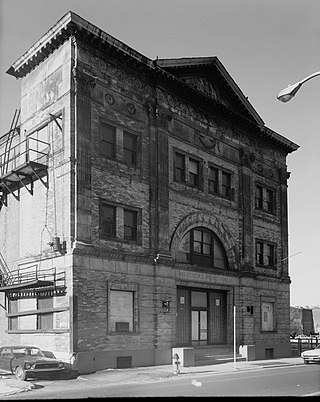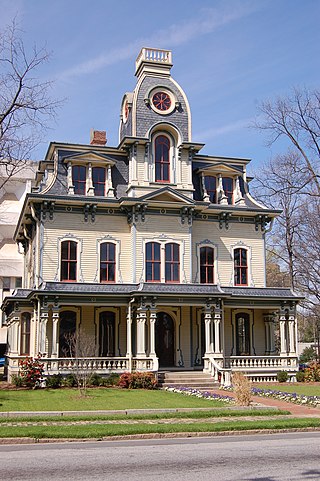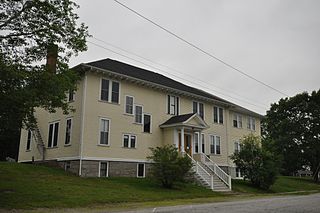
The University of Pennsylvania Campus Historic District is a historic district on the campus of the University of Pennsylvania, in Philadelphia, Pennsylvania, United States. The university relocated from Center City to West Philadelphia in the 1870s, and its oldest buildings date from that period. The Historic District was added to the National Register of Historic Places on December 28, 1978. Selected properties have been recorded by the Historic American Buildings Survey, as indicated in the table below.

Carpenters' Hall, in Independence National Historical Park in Philadelphia, Pennsylvania, is the official birthplace of the Commonwealth of Pennsylvania and a key meeting place in the early history of the United States. Completed in 1775, the two-story brick meeting hall was built for and is still privately owned by the Carpenters' Company of the City and County of Philadelphia, the country's oldest extant craft guild.

Samuel Sloan was a Philadelphia-based architect and best-selling author of architecture books in the mid-19th century. He specialized in Italianate villas and country houses, churches, and institutional buildings. His most famous building—the octagonal mansion "Longwood" in Natchez, Mississippi—is unfinished; construction was abandoned during the American Civil War.

Wilson Eyre Jr. was an American architect, teacher and writer who practiced in the Philadelphia area. He is known for his deliberately informal and welcoming country houses, and for being an innovator in the Shingle Style.

Harperly Hall is an apartment building on the Upper West Side of Manhattan, New York City. The building is located at the intersection of 64th Street and Central Park West and was built from 1910 to 1911. One of the city's few buildings designed in the Arts and Crafts style, Harperly Hall was designed by Henry W. Wilkinson. The structure was listed as a contributing property to the federally designated Central Park West Historic District in 1982 when the district was added to the National Register of Historic Places.

Charles Morrison Robinson, most commonly known as Charles M. Robinson, was an American architect. He worked in Altoona and Pittsburgh, Pennsylvania from 1889 to 1906 and in Richmond, Virginia from 1906 until the time of his death in 1932. He is most remembered as a prolific designer of educational buildings in Virginia, including public schools in Richmond and throughout Virginia, and university buildings for James Madison University, College of William and Mary, Radford University, Virginia State University, University of Mary Washington, and the University of Richmond. He was also the public school architect of the Richmond Public Schools from 1910 to 1929. Many of his works have been listed on the National Register of Historic Places.

The Wyck house, also known as the Haines house or Hans Millan house, is a historic mansion, museum, garden, and urban farm in the Germantown neighborhood of Philadelphia, Pennsylvania. It was recognized as a National Historic Landmark in 1971 for its well-preserved condition and its documentary records, which span nine generations of a single family.

The Estey Organ Company was an organ manufacturer based in Brattleboro, Vermont, founded in 1852 by Jacob Estey. At its peak, the company was one of the world's largest organ manufacturers, employed about 700 people, and sold its high-quality items as far away as Africa, Great Britain, Australia, and New Zealand. Estey built around 500,000 to 520,000 pump organs between 1846 and 1955.

The Merchants' Exchange Building is a historic building which is located on the triangular site bounded by Dock, 3rd and Walnut Streets in the Old City neighborhood of Philadelphia, Pennsylvania. It was designed by architect William Strickland, in the Greek Revival style, the first national American architectural style and was built between 1832 and 1834. It operated as a brokerage house in the nineteenth century, but by 1875 the Philadelphia Stock Exchange had taken the place of the Merchants' Exchange.

Estey Hall is a historic building on the campus of Shaw University in Raleigh, North Carolina. It was the first building constructed for the higher education of African-American women in the United States. Built in 1873, Estey Hall is the oldest surviving building at Shaw, which is the oldest historically black college in the South and was the second institution of higher learning established for freedmen after the Civil War. The building, originally known as "Estey Seminary," was named in honor of Jacob Estey, the largest donor to the construction project. Estey Hall, located in the East Raleigh-South Park Historic District, was listed on the National Register of Historic Places in 1973 and is a Raleigh Historic Landmark.

Leonard Hall is a historic educational building located on the campus of Shaw University in Raleigh, North Carolina. Built in 1881 and originally named Leonard Medical Center, it became known as Leonard Medical School, and then Leonard Hall. It was established when medical schools were professionalizing and was the first medical school in the United States to offer a four-year curriculum. It was also the first four-year medical school that African Americans could attend.

The Estey Tavern is a historic tavern in Middleton, Massachusetts. The 2.5-story wood-frame tavern house was built in 1753 by Samuel Bradford, who operated the tavern until 1763, when it was taken over by John Estey. The building is notable in part because its eastern ell encapsulates elements of a 17th-century building, including a chimney and some beams. The building has been converted to residential use, housing three living units.

The Musical Fund Hall is a landmark building of both architectural and historic significance located at 808 Locust Street in Philadelphia, Pennsylvania. The hall has hosted many notable speakers and events, including the first Republican National Convention from June 17 to 19, 1856.

The Homestead–Horton Neighborhood Historic District encompasses a small turn-of-the-20th century neighborhood area in Brattleboro, Vermont. Located on a portion of Canal Street and all of Horton and Homestead Places, the district includes a significant number of Queen Anne Victorians, as well as the Italianate home of Jacob Estey, proprietor of the Estey Organ Company, one of the city's larger employers. The district was listed on the National Register of Historic Places in 2009.

Alexander Rice Esty was an American architect known for designing many Gothic Revival churches in New England. His work also encompassed university buildings, public buildings, office buildings, and private residences across the Northeastern United States.

Chester Waterside Station of the Philadelphia Electric Company is a historic former coal-fired power station, located on the Delaware River in Chester, Delaware County, southeastern Pennsylvania.

George S. H. Appleget (1831–1880) was an American architect and carpenter. He was active in Philadelphia, New York, and North Carolina.

The Henry D. Moore Parish House and Library is an historic library and community meeting hall at 22 Village Road in Steuben, Maine. Built in 1911 and enlarged in 2007, it is a notable local example of a mix of Colonial Revival and Craftsman styles, and is the only known work in Maine of Philadelphia architect Isaac Parsell. The building was listed on the National Register of Historic Places in 2001.

H. Edwards Ficken (1852-1929) was an English American architect in practice in New York City.
























